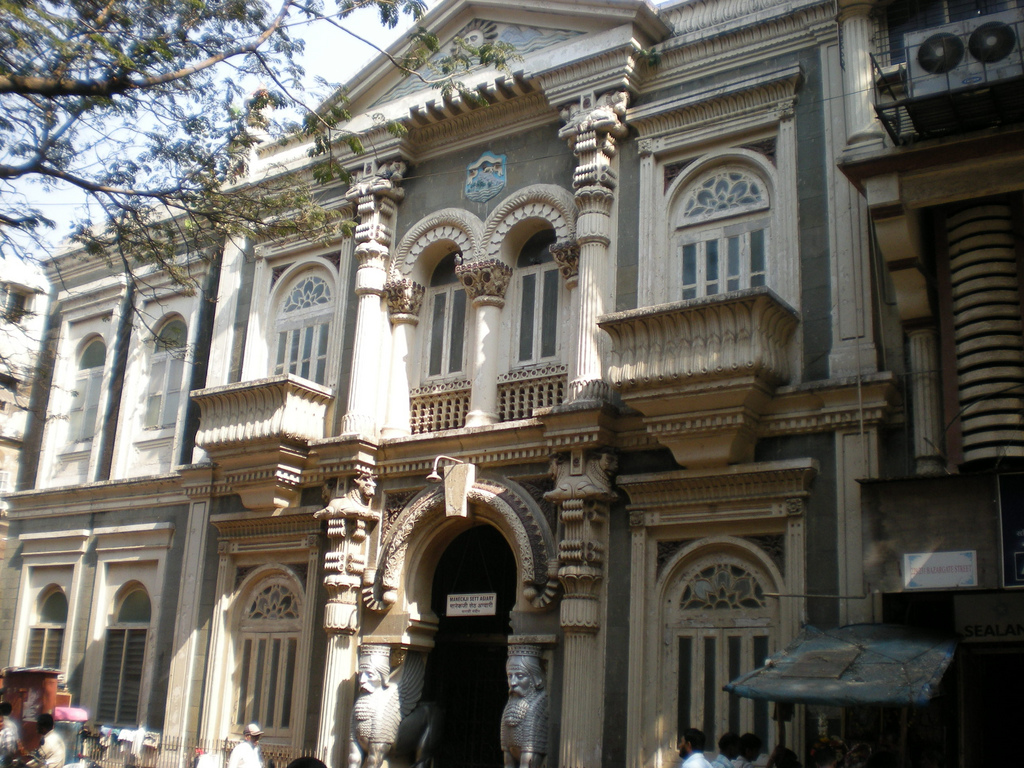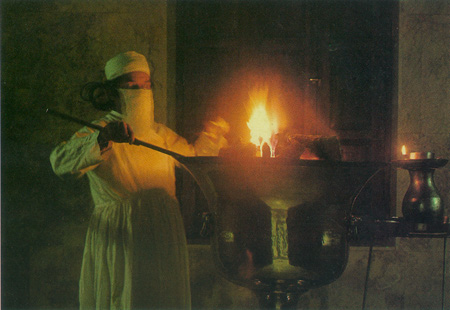راهرو عشق
راهرو عشق کویراست، که دریا بودنش را به آفتاب بخشید،آفتاب هم گرمی اش را نمی تواندبه همه نبخشد!راهرو عشق
راهرو عشق کویراست، که دریا بودنش را به آفتاب بخشید،آفتاب هم گرمی اش را نمی تواندبه همه نبخشد!atashebahram
| Anahita Amalsad
|
Click here for Anahita's Biography The History, Philosophy and Culture of Zoroastrianism Mary Boyce said, “Zoroastrianism is the oldest of the revealed world-religions, and it has probably had more influence on mankind, directly and indirectly, than any other single faith.” [1][1] The history of Zoroastrianism dates back to anywhere from 600 B.C.E. to 6000 B.C.E., with the most recent studies pointing to the Bronze Age, about 1800 B.C.E. to 1200 B.C.E. The main philosophy of Zoroastrianism is based on good thoughts, good words and good deeds. The Zoroastrian culture embraces many customs and rituals that may or may not be directly part of the religion. In this paper, I will be focusing on these aspects of Zoroastrianism: the history, philosophy and culture. There is no confirmed date that tells us when the history of Zoroastrianism started. The Gathas, hymns, suggest that Zoroaster lived at the time when the Bronze Age developed. According to this, we suppose that Zoroastrianism flourished at about 1800 B.C.E. to 1200 B.C.E. The Persian prophet, Zartosht, (later named as Zoroaster by the Greeks), which means the Golden Light or the Shining Star, founded Zoroastrianism. This religion prospered through the rise and fall of many civilizations. For 1,000 years, (558 B.C.E. to 652 C.E.) it was the main religion of three Persian Empires: the Achaemenians, the Parthians and the Sassanians.[2][2] This religion spread across Asia, from Greece in the west, to the Hindu Kush in the east, up into southern Russia and down into Egypt. Zoroastrianism had millions of followers. This religion then spread through Persia, and became the main religion of the Achaemenian Empire, founded by Cyrus the Great in 558 B.C.E. In 330 B.C.E., Zoroastrianism suffered many complications when Alexander the Great conquered Persia, burned Persepolis, and burned much of Zoroastrianism with it. The religion got rejuvenated during the Parthian and the Sassanian Empires. In 652 C.E., Zoroastrianism suffered another setback when the Muslims invaded Persia. At this time, a large number of Zoroastrians converted into Muslims. They got scattered due to massive persecutions, and today they are left with about 250,000 people across the world. A few shiploads of devoted Zoroastrians migrated to India in the 10th century and were given shelter. The major concentration of Zoroastrians is presently in Iran and India. There are approximately 25,000 Zoroastrians in North America, 7,500 in the United Kingdom, 4,000 in Europe, 2,000 in Australia and 3,000 in Pakistan. Some of the theological concepts shared by Zoroastrianism with Judaism and Christianity are: the belief in one supreme and loving God and that good ultimately prevails when one follows strict moral and ethical codes. The exchange of Zoroastrian thought or teachings with the Jewish and Christian beliefs first took place when Cyrus the Great defeated the Assyrians and released the Jews from Babylonian captivity. Therefore, the Zoroastrian philosophies have played an important role in the development of western religions and history. The main belief of Zoroastrian philosophy is based on good thoughts, good words and good deeds. Zoroastrians follow their faith by thinking good thoughts, speaking good words and by doing good deeds. The teachings of Zoroaster are mainly preserved in 17 hymns, known as Gathas, which are in the Yasna, part of the sacred Avesta scripture. This pocket book of Gathas has divine songs, filled with inspiring philosophies called the Manthra. Avesta, the holy book of the Zoroastrians, is a collection of prayers for daily use by the followers of this religion. When Zoroaster lived, the Persians were not familiar with writing. Therefore, for many centuries, all their religious works were handed down orally.[3][3] In the 5th century C.E., it was the first time that the Avestan alphabet was invented to actually write the Avesta. The simplest and most powerful prayer of the Zoroastrians is the Ashem Vohu prayer. This twelve-word prayer means: there is righteousness in the divine creation. Happiness comes to those who use their consciousness to be on the path of righteousness. Zoroastrianism is a religion of honoring the Wise Being, Ahura Mazda. Zoroastrians consider Ahura Mazda as their God. Zoroaster was the first prophet in the world who truly believed in monotheism. According to him, there is only one God, Ahura Mazda, the creator, maintainer and promoter of life. There are no assisting gods and goddesses. Mazda means supreme wisdom. Since God is a divine being, Zoroaster added Ahura to Mazda. Later, these two components were combined as Ahura Mazda, which translates as the Wise Lord. The concept of good and evil in Zoroastrianism has somehow been misunderstood and misinterpreted. In the Gathas, Zoroaster tells people that they have to choose between following the effective (righteous), or the ineffective path. This is different from believing that there are two equal and powerful opposing sources in the universe, whose constant struggle defines life and destiny. Zoroaster also believed in the freedom of choice through responsibility. He indicates in the Gathas to “Hear the best with your ears and ponder with your bright mind. Then make the choice between right and wrong, and accept complete responsibility for the consequences of your choice.”[4][4] Based on Zoroaster’s teachings, the reward and consequence of our actions are realized in this life. He emphasizes the individual’s role in making this world a better place for everyone. Zoroastrians follow a culture that consists of different customs and rituals, which show respect and reverence for their religion. Most cultures hold customs and rituals that may or may not be directly part of their religion. Many of the rituals and customs that the Zoroastrians follow are not described in the Gathas. But these rituals and customs are actual events that are symbolic to Zoroastrians. They exchange meaning and have real strength to influence us. There are many different customs that Zoroastrians follow. For example: First, they celebrate Novrooz, or Persian New Year, which is celebrated on the first day of spring. Khordad Saal, the birthday of Zoroaster, is celebrated on March 27th. Next, they celebrate Ghanbars, or seasonal Thanksgiving festivals. Finally, one of the most important ceremonies in the Zoroastrian religion is called Navjote, or the initiation ceremony.[5][5] A Zoroastrian child is officially initiated into the faith with the Navjote ceremony. During this ceremony, he or she is provided with the sacred Sudreh and Kushti, accompanied with recitation of prayers from the Avesta. The Sudreh is an undershirt of pure white muslin with a small symbolic pocket in front, reminding the wearer to fill it everyday with good thoughts, good words and good deeds. The Kushti, a woolen cord, signifies that the wearer has committed himself or herself to practice the teachings of Zoroaster. These customs often reflect their belief in the purity of the environment and their hopes for prosperity. Zoroastrians believe that cleanliness is next to Godliness. Therefore, in most of their rituals, they use fire as a symbol of cleanliness and are mistakenly labeled as fire worshippers by non-Zoroastrians. Zoroastrians are not fire worshippers. They just respect fire and light because they believe that life would be difficult without fire and light. Therefore, when they pray, they face the sun or a light source. In the Gathas, Zoroaster considers Atash, or fire, as mental light, warmth, and energy, three qualities that help one to transform good thoughts into good words and good deeds. Zoroaster also regarded Atash as a symbol of purity because it is the only element of nature whose sanctity is not affected by any kind of impurity because the energy radiated from fire destroys all impurities. For this reason, Zoroastrians consider fire as a sacred element, and have Fire Temples to worship Ahura Mazda. There are three grades of Fire Temples: Atash Bahram, Atash Adaram, and Dar-e-Meher. “The oldest existing Atash Bahram in the world is in the village of Sharifabad in Iran. Here the holy fire has been kept perpetually burning for over 2000 years…” [6] (Roshan Rivetna) Another old Fire Temple in Iran, is situated in the city of Yazd, which is called the center of Zoroastrianism. The holiest Fire Temple in India is the Atash Bahram at Udvada, about one hundred miles from Bombay, where the Sacred Fire brought by Iranian refuges from Iran has been continuously burning since 1741. In India, Pakistan and Iran, many Zoroastrians have built a special fireplace for prayers in their homes. This fire is called Atash Dadgah. Another symbol used by Zoroastrians is a Fravahar, a guardian spirit, or an inner voice. The Fravahar is a daily reminder to follow good thoughts, good words and good deeds, to keep promises, to respect the elderly and to choose the path of righteousness. As you can see, Zoroastrians have many different rituals and customs to show respect and admiration for their religion. In the last few pages, I have researched the history, philosophy and culture of the Zoroastrian religion. Most people do not know very much about this religion because it is the oldest monotheistic religion in the world. Most of the vital books and information about Zoroastrianism were first burned during the attack of Alexander the Great, and later destroyed by the Muslim invasion. Zoroastrian history was founded and taught in eastern Iran in about 1800 B.C.E. to 1200 B.C.E. This religion spread all over the Persian Empire by the 6th century B.C.E. Zoroastrianism flourished during the Achaemenians, the Parthians and the Sassanians Empires. The Zoroastrian kings, such as Cyrus the Great, were known for their tolerance and kindness towards other religions and races. Zoroaster, the founder of this religion, preached his main philosophy of good thoughts, good words and good deeds. The Zoroastrians holy book is called the Avesta; and their psalms are called the Gathas. Zoroastrians are supposed to respect other religions and choose the path of righteousness. The Zoroastrians follow certain customs and rituals to show love and respect for their religion. In most of their rituals, fire is used as a symbol of cleanliness and purity. Therefore, when they pray, they are to face the sun or a source of light. The most significant ritual in this religion is the Navjote, or the initiation ceremony, through which a child is officially accepted into the Zoroastrian faith. Most people have either not heard about this religion or have had misconceived concepts about its philosophy. I hope that my research paper on the history, philosophy and culture of Zoroastrianism, has clarified some misconceptions and brought more knowledge and understanding about this religion. ACKNOWLEDGMENT: I like to acknowledge the guidance, patience and support of my parents.
[1] Roshan Rivetna, The Legacy of Zarathushtra (Hinsdale: FEZANA, 2002), 22. [2] Roshan Rivetna, The Legacy of Zarathushtra (Hinsdale: FEZANA, 2002), 59 [3] Mary Boyce, Textual Sources for the Study of Zoroastrianism. (London, Manchester University Press, 1984), 1 [4] This is my parents’ understanding of the Gathas.
[5] Lorraine N. Moos, My Simple Book of Zoroastrianism. (New Delhi, Business Communicators, 1996), 36
[6] Roshan Rivetna, The Legacy of Zarathushtra (Hinsdale: FEZANA, 2002), 40. Bibliography Bowker, John. World Religions: The great faiths explored and explained. New York: DK Publishing Inc., 1997. Boyce, Mary. Textual Sources for the Study of Zoroastrianism. Manchester: Manchester University Press, 1984. Braden, Charles S. The World’s Religions. New York: Abington Press, 1976. Jagadeesan, J. Unity of Faiths. Kuala Lumpur: Sathya Sai Central Council of Malaysia, 1997. Moos, Lorraine N. My Simple Book of Zoroastrianism. New Delhi: Business Communicators, 1996. Rivetna, Roshan. The Legacy of Zarathushtra. Hinsdale: FEZANA, 2002. Roberts, Paul W. In Search of the Birth of Jesus: The Real Journey of the Magi. New York: Riverhead Books, 1995.
|
|
Agiary - List of Atash Behrams A selection of articles related to Agiary - List of Atash Behrams |
|
|
||||||||
| Agiary - List of Atash Behrams | ||||||||
 |
||||||||
ARTICLES RELATED TO Agiary - List of Atash Behrams |
||||||||
|
||||||||
|
||||||||
Related ArticlesArchitectural and Multi-Cultural Worship Places in Pune
Pune is the second largest city in the Maharashtra state. The city has many mosques, temples and other religious structures that stand as a story all its own. The people of Pune are great devotees and have deep sentiments about their local gods and goddess. Holy places in Pune reveal... Ceremonies In Parsi Weddings
Parsi marriages are called ‘Lagan’ and are quite different from Hindu weddings. Though Parsi weddings are simple, their rituals are spread over a week like other Indian marriages. For Parsis, marriage is an occasion of social and religious celebrations. This article highlights the traditions and customs followed in Parsi weddings. |
||||||||
 |
||||||||
| More material related to Agiary can be found here: |
| Main Page for Agiary |
YouTube Videos related to Agiary |
Index of Articles related to Agiary |
Index of Articles related to Agiary - List of Atash Be... |
Related Articles
Pune is the second largest city in the Maharashtra state. The city has many mosques, temples and other religious structures that stand as a story all its own. The people of Pune are great devotees and have deep sentiments about their local gods and goddess. Holy places in Pune reveal...
Parsi marriages are called ‘Lagan’ and are quite different from Hindu weddings. Though Parsi weddings are simple, their rituals are spread over a week like other Indian marriages. For Parsis, marriage is an occasion of social and religious celebrations. This article highlights the traditions and customs followed in Parsi weddings.
Grades of Fires and TemplesToday, there are three grades of fires: Atash Adaran, Agiary, AtashkadehAn Atash Adaran or fire of fires, is the second grade of
fire and is generally housed in an Agiari (also spelt Agiary, Agyari,
Agiyari - India, Gujerati) or Atashkadeh (Iran, Farsi), both meaning a
house of fire.
Early History of Mumbai's (Bombay's) Fire Temples
The history of Bombay /Mumbai's fire temples parallels
the history of Parsi settlement in Bombay and indeed the formation of
Bombay as a city and the financial hub of India.
When they took possession of the islands as part of
Portuguese Catherine of Braganza's dowry to King Charles II of Britain,
the British expressed disappointment their with the territory. However,
during the next one hundred and fifty years, the Parsees saw the
islands' potential and shaped the islands' early development and
physical outline.
In 1730 Manockji (spelt Maneckji today) Nowroji,
son of the great international Parsi trader Rustam Monock, arrived in
Bombay from Surat and lost no time in purchasing a large tract of land
on which he built a fire temple. Beside the fire temple, Manockji also
built a wadi or colony for Parsees to accommodate a growing Parsi
population, which by 1811, stood at 10,042 in Bombay town and Island. In
the Fort area itself had a total population of 10,801 in 1813, out of
which the Parsees numbered 5,364.
In 1786 and 1798, Mancherji Jivanji Readymoney and Dadibhai Nusserwanji Dadiseth respectively built private dakhmas for themselves and their families in Bombay.
Resource: The Parsis of India by Jesse S. Palsetia, BRILL, 2001. Atash Dadgah, Dar-e-Meher or Darbe Mehr
The Atash Dadgah, the court fire, is the third grade of
fire. Dadgah means court in Persian. For an explanation of the
development of this grade, see Dadgah - Courts
above. The grade came to include home and heart fires. Today, the Atash
Dadgah refers to any fire used in worship that is not consecrated. This
grade of fire does not require a priest in attendance and can be
attended to by the laity. » Early Fire Houses and Temples
|
» Site Contents |
|||||||||||||||||
Suggested prior reading: » Zoroastrian Worship
|
||||||||||||||||||||||||||||
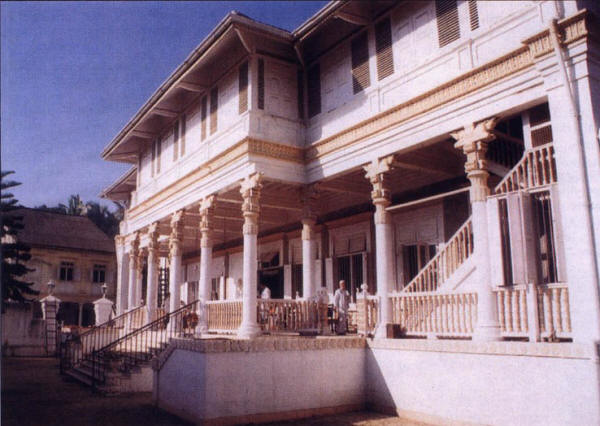 |
| Atash Bahram - Iranshah, Udvada, India |
| Credits: Various - photographer unknown. Currently at Zagny |
Desai / Bhagarsath Atash Bahram, Navsari, India
The fire of the Desai Atash Bahram in Navsari, India was
consecrated December 2, 1765 ACE (roz/day Sarosh, mah/month Ardibehest,
1135 AY)
Address: Tarota Bazar, Navsari, Gujarat.
 |
| Atash Bahram, Navsari, India |
| Photo Credit: Christopher / Krzysztof Arciszewski |
Dadiseth Atash Bahram, Mumbai, India
The Dadiseth (also spelt Dadyseth, Dadysett, Dadyset)
Atash Bahram was Mumbai / Bombay's first Atash Bahram. It was built by
Dadibhai Noshirwanji Dadyseth In 1771 CE.
The fire of the Dadiseth (Kadmi) Atash Bahram in Mumbai, India was consecrated September 29, 1783 (roz/day Govad, mah/month Aspandad, 1153 AY)
Address: Dadiseth Agiary Lane, Fanaswadi (near Chira Bazar), Dhobi Talao, (South) Mumbai.
 |
| Atash Bahram - Dadiseth (Kadmi), Mumbai, India |
| Credits: Various - photographer unknown. Currently at Zagny |
Modi Atash Bahram, Surat, India
The fire of the Modi (Shenshai) Atash Bahram in Surat, India was consecrated November 19, 1823 (roz/day Sarosh, mah/month Ardibehest, 1193 AY)
Address: Sayyadpura, Bhagol, Surat, Gujarat.
 |
| Atash Bahram - Mody/Shenshai, Surat, India |
| Credits: Various - photographer unknown. Currently at Zagny |
Vakil Atash Bahram, Surat, India
The fire of the Vakil (Kadmi) Atash Bahram in Surat, India was consecrated December 5, 1823 (roz/day Ardibehest, mah/month Khordad, 1193 AY)
Address: Shahpore, Surat, Gujarat.
 |
| Atash Bahram - Vakil/Kadmi, Surat, India |
| Credits: Various - photographer unknown. Currently at Zagny |
Wadia Atash Bahram, Mumbai, India
The fire of the Wadia (Shenshai) Atash Bahram in Mumbai, India was consecrated November 17, 1830 (roz/day Sarosh, mah/month Ardibehest, 1200 AY)
Address: Princess St, Dhobi Talao, Marine Lines, Mumbai.
 |
| Atash Bahram - Wadia (Shenshai), Mumbai, India |
| Credits: Various - photographer unknown. Currently at Zagny |
Banaji Atash Bahram, Mumbai, India
The fire of the Banaji (Kadmi) Atash Bahram in Mumbai, India was consecrated December 13, 1845 (roz/day Sarosh, mah/month Khordad, 1215 AY)
Address: Thakurdwar Road, Charni Rd, Mumbai.
 |
| Atash Bahram - Banaji (Kadmi), Mumbai, India |
| Credits: Various - photographer unknown. Currently at Zagny |
Anjuman Atash Bahram, Mumbai, India
The fire of the Zartoshti Anjumanna Atash Bahram in
Mumbai, India was consecrated October 17, 1897 (roz/day Ardibehest,
mah/month Ardibehest, 1267 AY)
Address: J. Shankarsheth Road, Dhobi Talao, Marine Lines, Mumbai.
 |
| Atash Bahram - Zartoshti Anjumanna, Mumbai, India |
| Credits: Various - photographer unknown. Currently at Zagny |
Yazd Atash Bahram, Yazd, Iran
The Yazd Atash Bahram in Yazd, Iran, was established 1934. A plaque states the flame has "been burning since about 470 ACE and was transferred from Nahid-e-Pars temple to Ardakan, then to Yazd and to its present site."
 |
| Atash Bahram, Yazd, Iran |
| Credits: Various - photographer unknown. Currently at Wikipedia |
» Early Fire Houses and Temples
» Modern Places of Worship. Agiary & Darbe Mehr
Suggested prior reading: » Zoroastrian Worship
Suggested further reading: » Zoroastrian Priesthood
» Site Contents
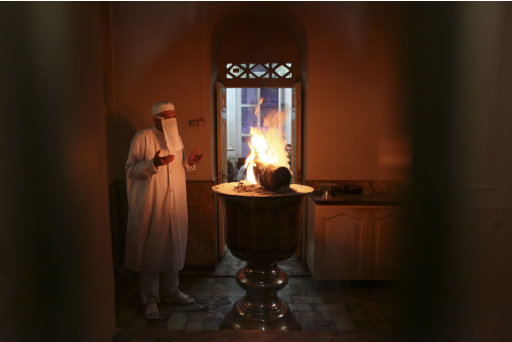 an
Iranian Zoroastrian priest, performs a ritual at a fire temple in
Tehran, Iran, Monday, Sept. 12, 2011. Zoroastrians are recognized in the
Iranian constitution as religious minorities who have their own
lawmaker in parliament. Zoroastrianism lost dominance in Iran after
Muslim Arabs conquered Persia in the 7th century. (AP Photo
an
Iranian Zoroastrian priest, performs a ritual at a fire temple in
Tehran, Iran, Monday, Sept. 12, 2011. Zoroastrians are recognized in the
Iranian constitution as religious minorities who have their own
lawmaker in parliament. Zoroastrianism lost dominance in Iran after
Muslim Arabs conquered Persia in the 7th century. (AP Photo
Suggested prior reading: » Zoroastrian Worship
Suggested further reading: » Zoroastrian Priesthood
Grades of Fires and Temples
Today, there are three grades of fires:
• Atash Bahram (or Atash Behram),
• Atash Adaran, and
• Atash Dadgah.
The three grades of fires have given rise to three principle (and somewhat arbitrary) grades of temples:
• Atash Bahram (or Atash Behram),
• Agiary (in India) or Atashkadeh (in Iran), and
• Darbe Meher/Dar-e-Mehr.
An
Atash Bahram and an Agiary (also spelt Agiari) or Atashkadeh have an
inner sanctum where the fire is maintained and where ceremonies of the
inner circle are conducted. This rectangular sanctuary, demarcated by
furrows, is called the pavi. Only
ritually purified priests can enter the pavi. The afringan or fire urn,
is placed on an elevated marble platform at the south end of the pavi.
Towards the north end of the pavi is the ritual instrument table, or
alat-khwan.
Atash Bahram / Behram
Atash Bahram or Atash Behram is the name given to both
the highest grade of fire and the temple that houses the Atash Bahram
(Victorious Fire). Atash Bahrams are under the care of a Dasturs, the high priests, assisted by a team of priests.
The
establishment and consecration of an Atash Bahram is the most elaborate
of the three grades of fires. Fires are gathered from sixteen different
sources, including lightening, fire from trades where a furnace is
operated, and the hearth fires of the asronih (priests), the
(r)atheshtarih (soldiers and civil servants), the vastaryoshih (farmers
and herdsmen) and the hutokshih (artisans and labourers). The fires go
through a consecration ritual before they join the others in the united
fire. The consecration ceremony requires thirty two priests and can take
up to a year for completion. (For a detailed description of the
consecration ceremony, see The Religious Ceremonies and Customs of the Parsees by J. J. Modi at avesta.org.)
There are nine Atash Bahrams: eight in India and one in Iran.
Iranshah Atash Bahram, Udvada, India
The Iranshah (Iranian King) Atash Bahram in Udvada,
India was established 1742 ACE. Its fire is said to have been
consecrated in 721 CE (roz/day Adar, mah/month Adar, 90 AY) at Sanjan,
Gujarat, India, shortly after a large group of Zoroastrians fled to
India's Gujarat coast following the Arab conquest of Iran. (Also see our
page on Pilgrimage Sites - Udvada).
The Atash Bahram in Udvada is called Iranshah, King of Iran, symbolically taking the place of the deposed Zoroastrian monarchy of Iran.
 |
| Atash Bahram - Iranshah, Udvada, India |
| Credits: Various - photographer unknown. Currently at Zagny |
Desai / Bhagarsath Atash Bahram, Navsari, India
The fire of the Desai Atash Bahram in Navsari, India was
consecrated December 2, 1765 ACE (roz/day Sarosh, mah/month Ardibehest,
1135 AY)
Address: Tarota Bazar, Navsari, Gujarat.
 |
| Atash Bahram, Navsari, India |
| Photo Credit: Christopher / Krzysztof Arciszewski |
Dadiseth Atash Bahram, Mumbai, India
The Dadiseth (also spelt Dadyseth, Dadysett, Dadyset)
Atash Bahram was Mumbai / Bombay's first Atash Bahram. It was built by
Dadibhai Noshirwanji Dadyseth In 1771 CE.
The fire of the Dadiseth (Kadmi) Atash Bahram in Mumbai, India was consecrated September 29, 1783 (roz/day Govad, mah/month Aspandad, 1153 AY)
Address: Dadiseth Agiary Lane, Fanaswadi (near Chira Bazar), Dhobi Talao, (South) Mumbai.
 |
| Atash Bahram - Dadiseth (Kadmi), Mumbai, India |
| Credits: Various - photographer unknown. Currently at Zagny |
Modi Atash Bahram, Surat, India
The fire of the Modi (Shenshai) Atash Bahram in Surat, India was consecrated November 19, 1823 (roz/day Sarosh, mah/month Ardibehest, 1193 AY)
Address: Sayyadpura, Bhagol, Surat, Gujarat.
 |
| Atash Bahram - Mody/Shenshai, Surat, India |
| Credits: Various - photographer unknown. Currently at Zagny |
Vakil Atash Bahram, Surat, India
The fire of the Vakil (Kadmi) Atash Bahram in Surat, India was consecrated December 5, 1823 (roz/day Ardibehest, mah/month Khordad, 1193 AY)
Address: Shahpore, Surat, Gujarat.
 |
| Atash Bahram - Vakil/Kadmi, Surat, India |
| Credits: Various - photographer unknown. Currently at Zagny |
Wadia Atash Bahram, Mumbai, India
The fire of the Wadia (Shenshai) Atash Bahram in Mumbai, India was consecrated November 17, 1830 (roz/day Sarosh, mah/month Ardibehest, 1200 AY)
Address: Princess St, Dhobi Talao, Marine Lines, Mumbai.
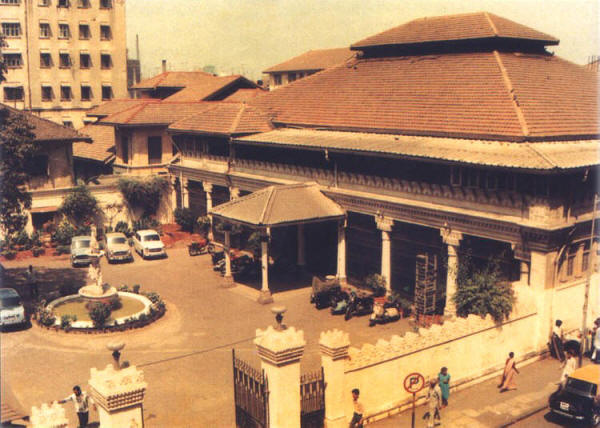 |
| Atash Bahram - Wadia (Shenshai), Mumbai, India |
| Credits: Various - photographer unknown. Currently at Zagny |
Banaji Atash Bahram, Mumbai, India
The fire of the Banaji (Kadmi) Atash Bahram in Mumbai, India was consecrated December 13, 1845 (roz/day Sarosh, mah/month Khordad, 1215 AY)
Address: Thakurdwar Road, Charni Rd, Mumbai.
 |
| Atash Bahram - Banaji (Kadmi), Mumbai, India |
| Credits: Various - photographer unknown. Currently at Zagny |
Anjuman Atash Bahram, Mumbai, India
The fire of the Zartoshti Anjumanna Atash Bahram in
Mumbai, India was consecrated October 17, 1897 (roz/day Ardibehest,
mah/month Ardibehest, 1267 AY)
Address: J. Shankarsheth Road, Dhobi Talao, Marine Lines, Mumbai.
 |
| Atash Bahram - Zartoshti Anjumanna, Mumbai, India |
| Credits: Various - photographer unknown. Currently at Zagny |
Yazd Atash Bahram, Yazd, Iran
The Yazd Atash Bahram in Yazd, Iran, was established 1934. A plaque states the flame has "been burning since about 470 ACE and was transferred from Nahid-e-Pars temple to Ardakan, then to Yazd and to its present site."
 |
| Atash Bahram, Yazd, Iran |
| Credits: Various - photographer unknown. Currently at Wikipedia |
» Early Fire Houses and Temples
» Modern Places of Worship. Agiary & Darbe Mehr
کلمات کلیدی مطالب
- atash bahram (۸)
- firetemple (٥)
- fire temples (٤)
- yazd (۱)
- customs (۱)
- zoroastrianism (۱)
- atash adaran (۱)
- atash dadgah (۱)
- spelling (۱)
- ceremonies (۱)
- image by hamazoor (۱)
- yazd schools (۱)
- agiary (۱)
- sharifabad (۱
- http://firetemple.persianblog.irبرگرفته از
Suggested prior reading: » Zoroastrian Worship
































